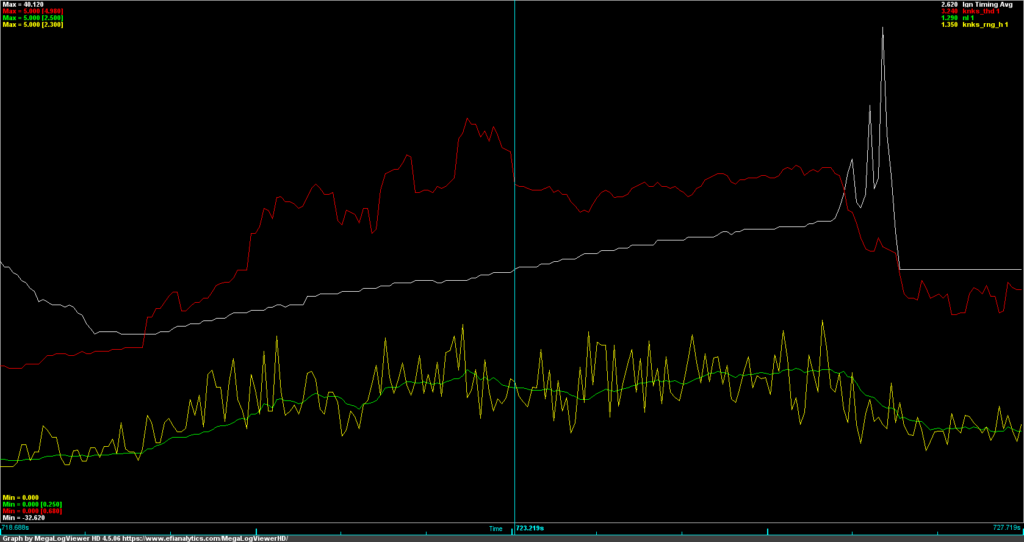
Background:
Knock, or detonation, is a type of abnormal combustion that can cause serious engine damage in a very short amount of time.
High Performance Academy
And in my opinion, is the number one killer of performance engines.
This page presents a brief introduction to the topic of engine knock and variables that are utilized by the Simos 18 engine management software to avoid, detect, and mitigate knock and its deleterious effects.
The reason for the explanation is that knock-related information that is unavailable from the Cobb Accessport is being presented in the Cobb tune comparison results.
Detonation is caused by too much cylinder pressure, and that could be caused by a number of things. It’s usually too much of things you think are good. Too much boost pressure, too much ignition advance, those are the main causes of detonation that we’ve seen.
MotoIQ – 3 Ways to Prevent Your Engine from Blowing Up!
This short three-minute video from High Performance Academy introduces the topic of knock and its detection:
In this video from MotoIQ, they show examples of damage resulting from detonation that ranges from mild to severe (starting around 8:35).
A key point to take away from this is that just because your engine is still running doesn’t mean that it isn’t being damaged if detonation is occurring. For example, a possible symptom that knock has occurred is a broken spark plug.
Simos 18 Knock Management:
Continental Automotive Group publishes a document called the Simos 18 Funktionsrahmen that provides details about how the ECU software manages the engine operation, including the handling of Knock events. The document is over 27,000 pages in length and even just the section on Knock (KNCK) is very comprehensive and detailed.
Even without understanding all of the details, there are some key points from the Knock section that help understand how the system functions on a Mk7, which will be beneficial to interpreting data that I have logged for each of the Cobb tunes.
The next two charts show a snippet of time where important noise-related variables are plotted together along with an explanation of what they represent.
In plain language, the system works as follows:
1) The Knock Sensor continuously samples the varying noise levels in the engine, shown with the blue line.
2) This instantaneous noise level is processed into a moving average noise level, the green line.
3) The average noise level has a gain factor multiplied by it, and then an offset value is added. This results in a knock threshold, the red line.
4) If at any moment the instantaneous noise level (blue line), exceeds the Knock threshold (red line), safety measures are enacted, and ignition timing retard results.

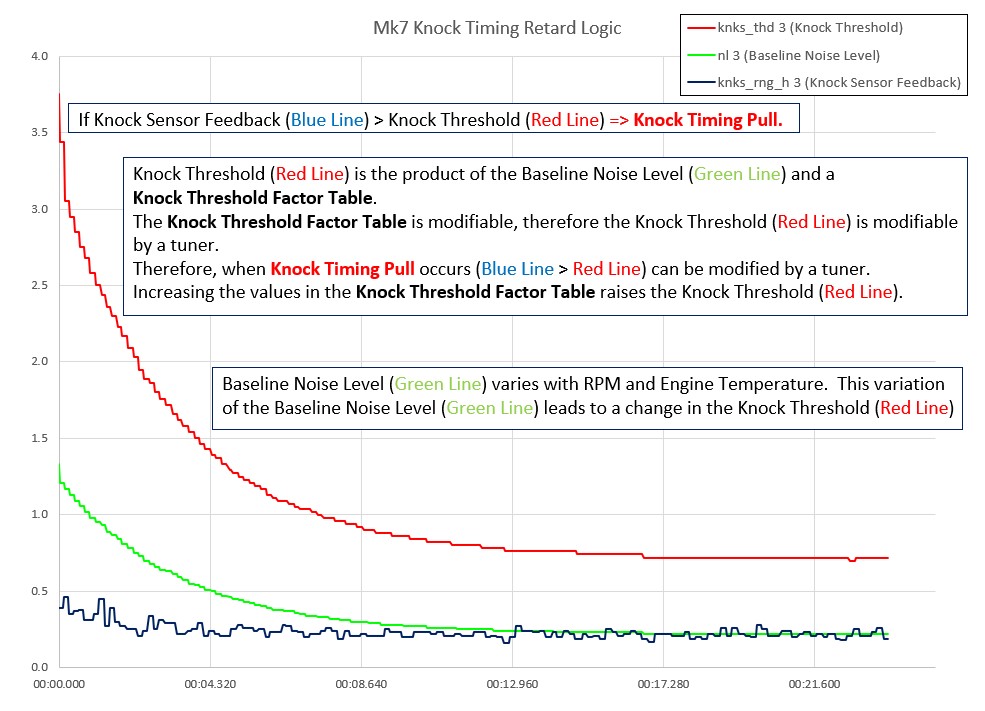
This short video from High Performance Academy demonstrates a knock sensor monitoring an engine and timing being pulled when the knock signal level exceeds the knock threshold.
Simos 18 – Calculating Knock Threshold:
The formula for calculating the Knock Threshold looks as follows:
Knock Threshold = Average Noise Level * Gain + Offset
As the Simos 18 Funktionsrahmen explains, the process for establishing the knock sensor signal acquisition involves calibration on an engine testbench using cylinder pressure sensors to verify the correlation between knock events and overpressure for all engine operating points.
From this calibration, a table of values for the Knock Threshold gain is developed.

Increasing the table values will raise the knock threshold (red line), making it less likely for the instantaneous noise signal to surpass the knock threshold.
If it was desired to make it so that a tune doesn’t implement Knock Retard, a tuner can raise the values in the Knock Threshold Gain table (aka Numbing the Knock Sensors) from those set by the OEM.
Cobb Accesport Knock Retard:
Arguably the most often cited measure indicating tune “safety” is the Knock Retard by cylinder. Having little or no Knock, or Detonation, is beneficial for a long service life from the engine, and tunes that show little to no Knock with an Accessport are hailed as safe and reliable.
Unfortunately, the Accessport does not necessarily report instances of Knock/Detonation accurately, (this limitation is also present with several other OBD data logging devices), and consequently, any conclusion about tune safety based on Cobb’s Knock Retard value is potentially flawed.

The reason for this is that the knock sensor signal is processed before a Knock Retard value is reported on the Accessport. This processing of the knock signal is subject to manipulation by a software tuner by altering the table values from what the OEM calibration defined. The Accessport reports the ignition timing adjustment (Knock Retard) value after the noise signal has gone through processing.

Only the last approach is a topic of this evaluation.
Noise Variable Logging:
The variables shown in the charts above (Knock Sensor Signal, Baseline Noise Level, Knock Threshold) should be recorded to gain knowledge of how “safe and reliable” a tune is in terms of Knock management.
Although the Cobb Accessport does not report these important variables, I am using a different datalogger that will record these variables when a Cobb-based tune is installed on my GTI’s ECU.
Real World Example:
Here is an example of the insight these variables provide using data that was recorded during full-throttle third-gear pulls from a tune that uses an OEM-like Knock Threshold, and one with an elevated Knock Threshold.
In the OEM-like Knock Threshold case the Noise Signal (Blue line) from the knock sensor spikes above the Knock Threshold (Red line), and the ECU reacts to the potential Knock Event by reducing Ignition Timing (Knock Retard) (Cyan line), and the Accessport reports a value for Ignition Timing Retard on Cylinder #1.
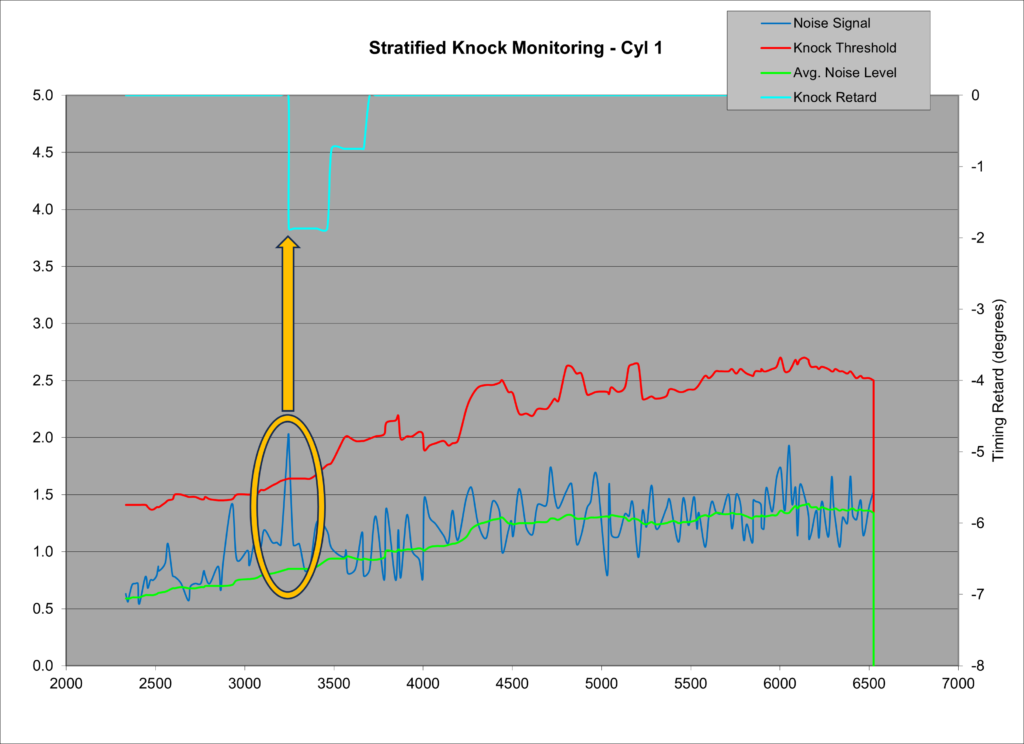
In this next example, a tune with the Knock Sensors “Numbed” encounters the same magnitude of Noise Signal (Blue line) spike.
In this case, the tuner has raised the Knock Threshold (Red line) so the ECU does not process this noise spike as a potential Knock Event, and no safety measures are employed – timing is not reduced.
The Accessport reports zero (0) for the Ignition Timing Retard on cylinder #1 even though the same potential Knock Event has occurred as in the first example.
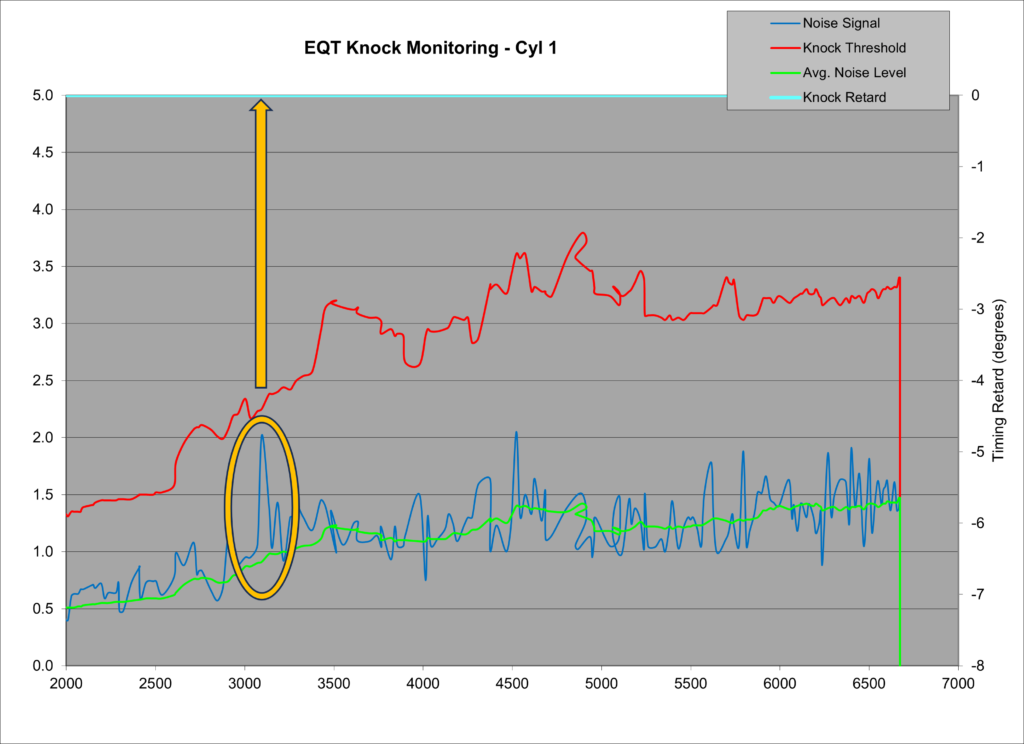
Reporting Format:
Most of the results on the Street Data and Dyno Data pages that are related to the Noise variables are presented as changes compared to the OEM values.
This data is derived as follows:
1) The difference between the Stock Noise Threshold and the Average Noise Level is the Stock Delta (red arrow).
2) The difference between the Sneeky Tuned Noise Threshold and the Average Noise Level is the Sneeky Delta (orange arrow).
3) The value of the Stock Delta is subtracted from the Sneeky Delta and this difference is divided by the value of the Stock Delta. The result is the percentage increase in the Sneeky Noise Threshold compared to the Stock Noise Threshold.
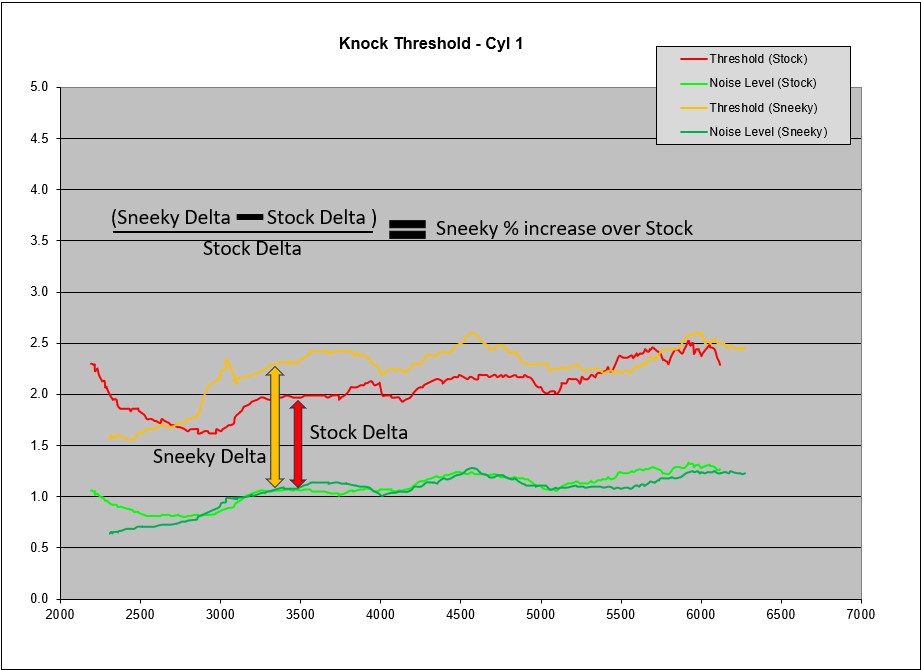
The larger the percentage value becomes the more the Noise Threshold is being raised above the OEM levels.
A Noise Threshold similar to the OEM levels would produce a line close to 0%. With the OEM difference serving as a baseline, it is possible to see if the aftermarket tunes alter the OEM safety margins, and by how much.
This chart shows dyno recorded data averages for two tunes that have raised the Knock Threshold above the OEM values:

